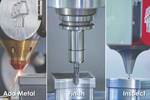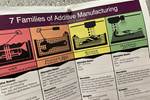Infographic: The Seven Families of Additive Manufacturing Technologies
An infographic from Hybrid Manufacturing Technologies offers a quick overview of the seven “families” of additive manufacturing.

Infographic courtesy of Hybrid Manufacturing Technologies. Click here to download a printable copy.
Editor’s note: Hybrid Manufacturing Technologies updates this graphic on a yearly basis. The most recent can always be found in the Resources section of the company’s website.
In the mainstream media, “3D printing” has become a shortcut way of describing all additive manufacturing technologies. It’s problematic, though, because it tends to conjure an image of just one type of 3D printing—the desktop style many people may have seen in their local library or child’s classroom. But AM is much more than plastic extrusion; there are so many technologies that can be considered “additive” that it can be difficult to keep them straight even if you’re familiar with them, let alone explain the differences to friends, colleagues or customers who aren’t.
This infographic produced by Hybrid Manufacturing Technologies delineates the distinct characteristics of each of the seven according to ASTM F2792 standards (“hybrid” technologies such as the company’s Ambit printhead that integrate AM with other processes might be considered an eighth category). While not meant to be comprehensive, this graphic could be a helpful aid for visitors, students or customers who need a fast overview of the technology differences.
Click here or visit Hybrid Manufacturing’s Resources page to download a printer-friendly PDF of this infographic.
Related Content
-
3D Printing with Plastic Pellets – What You Need to Know
A few 3D printers today are capable of working directly with resin pellets for feedstock. That brings extreme flexibility in material options, but also requires greater knowledge of how to best process any given resin. Here’s how FGF machine maker JuggerBot 3D addresses both the printing technology and the process know-how.
-
A Framework for Qualifying Additively Manufactured Parts
A framework developed by The Barnes Global Advisors illustrates considerations and steps for qualifying additively manufactured parts, using an example familiar to those in AM: the 3D printed bottle opener.
-
AM 101: Digital Light Synthesis (DLS)
Digital Light Synthesis (DLS) is the name for Carbon's resin-based 3D printing process. How it works and how it differs from stereolithography.

.jpg;width=70;height=70;mode=crop)






